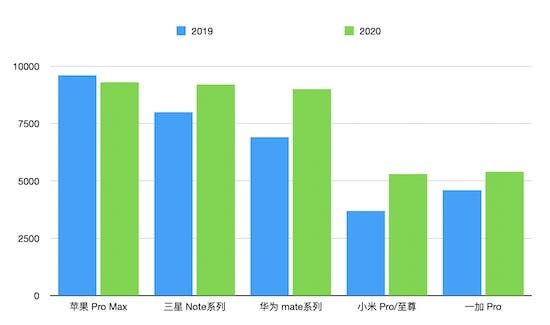When we compare the prices of smartphones in 2019 and 2020, flagship phones will undoubtedly have a big price increase. This means that when users want to buy the top flagship product of a certain brand, they need to spend more than before. Even if you want to have a standard flagship model similar to the past, it will cost a lot of money.
All Android Flagship Smartphones Increased Prices
The first thing that clearly shows the price increase for the flagship models is that there are many brands designing and launching premium smartphones. Say, besides the Samsung Galaxy S20 Ultra, Huawei P40 Pro+, and the Xiaomi Mi 10 Ultra, there are also amazing models from OPPO Find series, OnePlus and others.

After comparing the starting prices of the highest-end products of various manufacturers in 2019 and 2020, it is not difficult to find that in addition to the price drop of the Apple iPhone Pro Max series, the top products under other brands have a certain price increase. At the same time, in addition to OnePlus, the major brands have also adopted new names to interpret their new products.
Among them, Samsung Note series changed from 7999 yuan ($1225) for Note 10+ 5G version to 9199 yuan ($1409) for Note 20 Ultra 5G version; Huawei Mate series changed from 6899 yuan ($1056) for Mate30 Pro to 8999 yuan ($1378) for Mate40 Pro+; Xiaomi changed from Mi 9 Pro 5G at 3699 yuan ($566) to 5299 yuan ($811) for the Mi 10 Ultra; OnePlus has changed from 4599 yuan ($704) for OnePlus 7T Pro to 5399 yuan ($827) for OnePlus 8 Pro.
It is also worth noting that Apple not only lowered the price of the Pro Max series from 9599 yuan ($1470) to 9299 yuan ($1424), but also expanded the initial capacity of the model from 64GB to 128GB. So this is equivalent to not only lowering the price but also doubling the capacity.
Samsung and Apple Basically Do Not Make Many Changes In Their ‘Standard’ Models
However, despite the high prices of top flagship models of various brands, manufacturers like Samsung and Apple are also keeping the prices of standard flagship models unchanged.
The price of the Samsung Galaxy S20 series at the beginning of the release is undoubtedly the same as that in 2019. The price of the Galaxy S20 is starting at 6,999 yuan ($1072), while the price of the Galaxy S10 in 2019 is starting at 5999 yuan ($819). Thus, the price has increased by 1,000 yuan. However, Samsung also launched the Galaxy S20 FE in the second half of the year, priced at 4999 yuan ($765), maintaining the same level as the 2019 Galaxy S10e.
Coincidentally, Apple’s iPhone 12 starts at 6,299 yuan ($964), which is 800 yuan compared to the 5,499 yuan ($842) on the iPhone 11 in 2019. However, Apple also launched the iPhone 12 mini with a small size as a selling point, priced at 5499 yuan ($$842). Thus, it maintained the same level with the iPhone 11.
Undoubtedly, Samsung and Apple are launching new flagship models to make up for the market vacancies caused by the rise in prices of standard flagship models. At the same time, the processor and related main functions have not been shrunk. So the product can maintain almost the same experience as the top products for most daily tasks.
Who Puts The Pressure On?
However, the price increase of flagship killers in 2020 may mean that some consumers may not only miss the top flagship in the future, but will gradually miss the standard flagship configuration. Just like the Core i9 model in the current PC market, not all consumers intended to empty their pockets.
The price of the Xiaomi Mi 9 in 2019 started at 2,999 yuan, and in 2020, the price of the Xiaomi Mi 10 starts at 3,999 yuan ($612). The company also stated at the time: ‘This configuration can cost more than 4,000 yuan at friends. ‘
The price of the 2019 OnePlus 7 is also starting at 2,999 yuan ($459). In 2020, the price of OnePlus 8 has also changed to 3999 yuan ($612).
Obviously, increase of smartphone prices make many customers wait for better configurations and features. Plus, with the increase in prices, users with limited financial capabilities likely won’t buy flagship models. After all, the financial burden of buying a new flagship phone is growing.






Place comments
0 Comments
You are currently seeing only the comments you are notified about, if you want to see all comments from this post, click the button below.
Show all comments